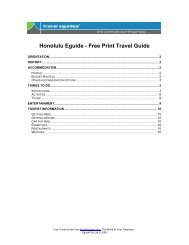Australia Eguide - Travel Guides
Australia Eguide - Travel Guides
Australia Eguide - Travel Guides
Create successful ePaper yourself
Turn your PDF publications into a flip-book with our unique Google optimized e-Paper software.
151<br />
South <strong>Australia</strong><br />
The South <strong>Australia</strong>n Colonization Act received the royal assent of King William IV on<br />
15th August 1834, the first colonists arriving on 20th July 1836 and landing on Kangaroo<br />
Island, the first place in South <strong>Australia</strong> to be settled.<br />
The new Governor of South <strong>Australia</strong>, John Hindmarsh, arrived on 28th December 1836,<br />
together with the Surveyor-General, Col. William Light, who first visited the present site<br />
of Adelaide on 30th December 1836, soon choosing it for the new capital.<br />
So began the history of the state. South <strong>Australia</strong> claims that it is the driest state in the<br />
driest continent on earth. With such a record, it is no wonder that agricultural<br />
development has always presented a problem here. However, wheat is grown in the<br />
coastal areas, including the Eyre Peninsula to the west of Adelaide, and this region<br />
extends almost as far west as the start of the Nullarbor Plain. However, it cannot continue<br />
very far inland.<br />
The most famous rural area of the state is the Barossa Valley, which attracted German<br />
immigrants right from the start and soon became <strong>Australia</strong>’s first and most important<br />
wine-growing region, a reputation which it maintains. The Barossa Valley is close to<br />
Adelaide and can easily be reached as a day excursion from the capital.<br />
South <strong>Australia</strong> also produces minerals. Copper was discovered at Burra in 1845 and gold<br />
was also discovered in the same year. In recent times, however, it has been the iron ore<br />
from Whyalla which has been the most important mineral product. In addition, the lead,<br />
zinc and silver from Broken Hill is mainly transported by rail to Port Pirie, even though<br />
Broken Hill lies geographically narrowly within the borders of New South Wales. At Port<br />
Pirie, therefore, can be found the largest lead smelter in the world.<br />
Towards the north of the state are two of <strong>Australia</strong>’s three main opal mining<br />
communities. The better known is Coober Pedy, on the way to Alice Springs. A little less<br />
famous is Andamooka, to the south-east of Coober Pedy. In terms of scenery, South<br />
<strong>Australia</strong> offers some attractive coastal views all the way from the Eyre Peninsula in the<br />
west to Mt. Gambier in the east. It offers Kangaroo Island with its history as well as<br />
wildlife. It offers the European flavour of the Barossa Valley. It offers the stately Flinders<br />
Ranges some seven hours north of Adelaide, and, for the really adventurous, it offers<br />
outstanding outback travel to the huge Lake Eyre, or along the Birdsville, Strzelecki or<br />
Oodnadatta Tracks, all of which can be covered with tours, although not with ordinary<br />
public transport.<br />
South <strong>Australia</strong> used to have its own state railway system. Indeed the state lays claim to<br />
having had <strong>Australia</strong>’s first railway line, albeit a horse-drawn railway - between Goolwa<br />
and Victor Harbor. Because of the desirability of connecting its lines with those of<br />
Victoria, South <strong>Australia</strong> chose to copy the Victorian gauge of 5 feet 3 inches and that led<br />
to problems later, especially as the state also used a 3 feet 6 inches gauge in rural areas to<br />
save construction costs and then found itself linked to the west by the standard 4 feet 8½<br />
Free from <strong>Travel</strong><strong>Eguide</strong>s.com Online <strong>Travel</strong> Information.<br />
©2008 <strong>Eguide</strong> Pty Ltd




